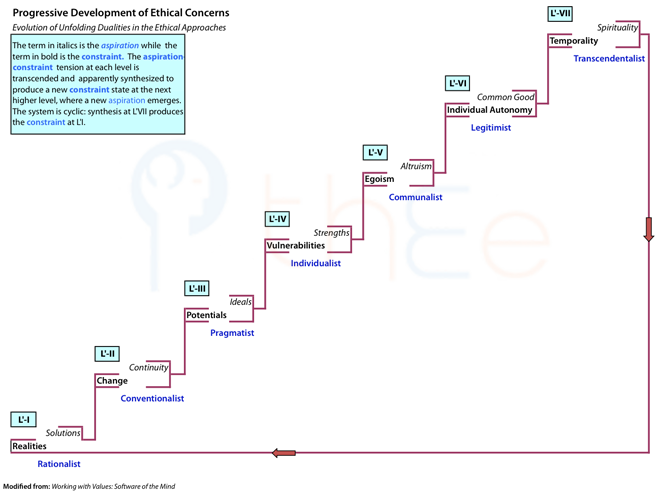More on Ethical Choice Approaches
Philosophers' Duality
In philosophy-speak, an ethics is called:
- teleological if it specifies or implies intentionality and the requirement to determine and follow what is good; &
- deontological if it specifies or implies duty and the requirement to determine and follow what is right.
Inquiry reveals that these two terms are a typical oscillating duality: i.e. they correspond to distinctive characteristics of odd and even Levels in the THEE hierarchy. The situation is shown in this Matrix Table.
| L' | Approach | Core Obligations | Philosophical Classification |
|---|---|---|---|
| I' | Meeting practical objectives which are self-evidently sensible and worthwhile to the chooser. | Teleological | |
| II' | Conforming with widely held views on what is valued and proper within the chooser's relevant social group. | Deontological | |
| III' |
(syn. ) |
Pursuing values that are preferred by the chooser's group, bring some general benefit and are easily applied. | Teleological |
| IV' | Ensuring the chooser's security and interests in the light of the existing power relations. | Deontological | |
| V' | Balancing all anticipated consequences in relation to the needs and interests of all concerned, including the chooser. | Teleological | |
| VI' | Setting a rule which is accepted as right by the chooser and all others in the social group. | Deontological | |
| VII' | Responding to the chooser's deep inner (and essentially divine) sense of what is right and good. | Teleological |
The Unfolding Duality
The form the unfolding duality.This operates as a thesis-antithesis leading to a synthesis which is the thesis generating a new antithesis at the next higher level. The system is cyclic: i.e after L7, the next higher level is L1.
To see it, ![]() click here ►
click here ►
Using the Approaches
The differences between the approaches show up markedly when we observe them in use. This will be explored when we post in the future.
To get a better feel for each approach now, ![]() click to study the matrix ►
click to study the matrix ►
-
There is much more to : and . These all impact on choices that are made or lead to judgements about whether the choices are right. See more in various Chapters in Working with Values
 .
. -
Continue to linking politics with ethics.
Originally posted: July 2009; Last updated: 27 Jan 2010
All posted material is part of a scientific project and should be regarded as provisional. Visitors are encouraged to think through the topics and propositions for themselves. Copyright © Warren Kinston 2009-2016.
All Rights Reserved.
